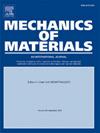纳米金属间化合物在Ti-Ni双金属合金中的原子界面强化机制
IF 3.4
3区 材料科学
Q2 MATERIALS SCIENCE, MULTIDISCIPLINARY
引用次数: 0
摘要
Ti-Ni金属间化合物(IMCs)引起的裂纹严重影响了Ti-Ni双金属合金在极端环境中的应用。然而,最近的研究表明,将这些原本有害的imc的尺寸从微米级减小到纳米级可以提高金属的塑性和强度。为了研究纳米IMCs对高应变下Ti-Ni双金属合金变形机制的影响,采用分子动力学(MD)模拟研究了Ti-Ni双金属合金界面上常见的两种IMCs (Ti2Ni和TiNi3)的力学变形机制,以及它们对合金界面结合强度的影响。考虑了层状和颗粒结构。单轴拉伸试验结果表明,屈服后Ti2Ni发生了原子尺度的重排,表现出高延展性和低强度。相比之下,TiNi3是高度脆性的,表现出有限的滑移。在Ti- ni双金属合金中,由于Ti2Ni结构中缺乏长程有序,层状Ti2Ni与Ti层之间的界面极易受到应力集中的影响。层状tin3与Ti层之间的半相干界面是导致Ti- ni界面脆性的主要原因。此外,颗粒IMCs的存在作为位错源,激活Ni层中的滑移,从而以牺牲一定强度为代价提高整体塑性。我们的模拟工作为设计高性能Ti-Ni双金属合金提供了一种潜在的方法,并阐明了Ti2Ni和TiNi3在合金基体中的变形机制。本文章由计算机程序翻译,如有差异,请以英文原文为准。
Atomic-scale interfacial strengthening mechanism of nano intermetallic compounds in Ti-Ni bimetallic alloys
It is well established that cracking induced by Ti-Ni intermetallic compounds (IMCs) severely compromises the application of Ti-Ni bimetallic alloys in extreme environments. However, recent research has demonstrated that reducing the size of these originally detrimental IMCs from the micrometer to the nanometer scale can enhance the plasticity and strength of the metal. To investigate the effects of nanoscale IMCs on the deformation mechanisms of Ti-Ni bimetallic alloys under high strain, we employed molecular dynamics (MD) simulations to study the mechanical deformation mechanisms of two common IMCs at the interface of Ti-Ni bimetallic alloys, namely Ti2Ni and TiNi3, and their influence on the interfacial bonding strength of the alloy. Both lamellar and particulate configurations were considered.The results of uniaxial tensile tests reveal that Ti2Ni undergoes atomic-scale rearrangement after yielding, exhibiting high ductility but low strength. In contrast, TiNi3 is highly brittle and exhibits limited slip. In the context of Ti-Ni bimetallic alloys, the interface between lamellar Ti2Ni and the Ti layer is highly susceptible to stress concentration due to the lack of long-range order in the Ti2Ni structure. The semi-coherent interface between lamellar TiNi3 and the Ti layer is the primary cause of brittleness at the Ti-Ni interface. Additionally, the presence of particulate IMCs acts as dislocation sources, activating slip in the Ni layer, thereby enhancing overall plasticity at the expense of some strength.Our simulation work provides a potential approach for designing high-performance Ti-Ni bimetallic alloys and elucidates the deformation mechanisms of Ti2Ni and TiNi3 within the alloy matrix.
求助全文
通过发布文献求助,成功后即可免费获取论文全文。
去求助
来源期刊

Mechanics of Materials
工程技术-材料科学:综合
CiteScore
7.60
自引率
5.10%
发文量
243
审稿时长
46 days
期刊介绍:
Mechanics of Materials is a forum for original scientific research on the flow, fracture, and general constitutive behavior of geophysical, geotechnical and technological materials, with balanced coverage of advanced technological and natural materials, with balanced coverage of theoretical, experimental, and field investigations. Of special concern are macroscopic predictions based on microscopic models, identification of microscopic structures from limited overall macroscopic data, experimental and field results that lead to fundamental understanding of the behavior of materials, and coordinated experimental and analytical investigations that culminate in theories with predictive quality.
 求助内容:
求助内容: 应助结果提醒方式:
应助结果提醒方式:


